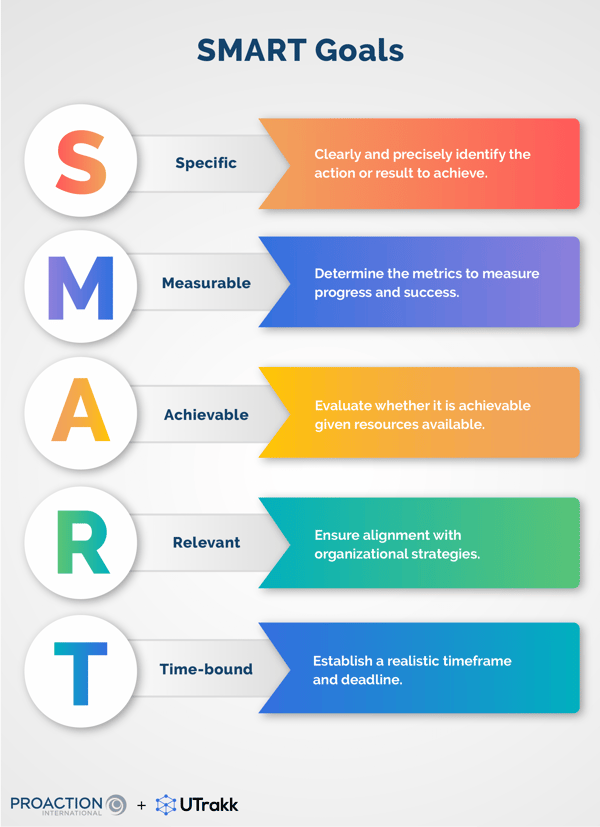What are SMART goals?
The SMART framework began with the concept of “management by goals,” described by Peter F. Drucker in 1954 in his book The Practice of Management. Then, in 1981, George T. Doran wrote an article entitled There's a S.M.A.R.T. Way to Write Management's Goals and Objectives, conceptualizing this method and using the term “SMART” to designate it.
Today, it has become a benchmark for optimally structuring professional goals, making them straightforward to everyone and actionable.
Each letter of the SMART acronym corresponds to a specific criterion:
- Specific: The goal must be clear and precise. It concerns an action or a result.
- Measurable: The goal must be quantifiable, i.e., include indicators for measuring progress and success.
- Achievable: The goal must be ambitious but attainable, i.e., reached within the allotted time using the available human and material resources.
- Relevant: To avoid unnecessary effort, the goal must contribute directly to the company's priorities and global or strategic objectives.
- Time-bound: The goal must have a deadline to stay on course.

The importance of SMART goal setting for employees
Whether at a 5-minute briefing at the start of the day or during a meeting, the manager's ability to guide the work of their teams by setting SMART goals is essential.
Let's take a look at the concrete benefits of implementing SMART goals:
Clarify expectations
The SMART method enables managers to define goals precisely, avoiding any ambiguity. Thanks to this clarity, teams better understand what is expected of them, facilitating their work while reducing misunderstandings and wasted time and effort. That way, everyone is on the same page.
Raise accountability and a result-oriented attitude
Precise and measurable SMART goals empower employees as they see how their work directly influences the company's results. At the same time, setting realistic but challenging deadlines creates a positive sense of urgency that encourages teams to take action to achieve goals on time.
Align individual and strategic goals
SMART goals help link employees' professional aspirations with corporate priorities. For example, if an employee wishes to develop their management skills in project coordination, their manager may set him the goal of coordinating a specific initiative. This goal will thus both help the employee progress and contribute to the organization's strategic objectives.
Increase team engagement
When goals are well defined, it's easier for the manager to engage workers in collective efforts around these SMART goals. This helps create a sense of unity and collaboration, which is essential for maintaining motivation and maximizing productivity.
Improve recognition of efforts and results
The SMART method makes progress visible through clear indicators, enabling achievements to be valued, which in turn strengthens employees' recognition and satisfaction.
Facilitate project management
The SMART method provides managers with a structured framework for planning and monitoring projects. Thanks to precise and relevant goals, they can allocate the necessary resources precisely and prioritize the actions to be taken.
Ensure accurate monitoring and tracking
By defining measurable SMART criteria, it becomes easier to monitor the progress of implemented initiatives, quickly identify gaps or obstacles, and adjust strategies accordingly.
How to set SMART goals to boost performance
To write SMART goals, you must ask yourself the right questions at every stage of their definition.
1. Specific
Identify what you want to achieve.
A specific goal answers the following questions:
- What precisely is the expected result?
- Why is this goal important?
- Who is responsible for achieving it?
- What means or actions need to be put in place?
For example, instead of “Improve customer service,” a specific goal could be “Reduce customer response time to less than 5 minutes on online chat.”
2. Measurable
Determine success indicators. You need precise criteria to evaluate the progress of a SMART goal.
A measurable goal answers the following questions:
- What numbers or data will track progress?
- How will you know when the goal has been reached?
- How often will you measure results?
For example, instead of “Increase sales,” a measurable goal might be “Increase monthly sales by 10% over the next 6 months.”
3. Achievable
Check the feasibility of the goal compared to the elements you have at your disposal and any potential obstacles.
An achievable goal answers the following questions:
- Do we have the necessary resources (time, budget, skills)?
- What obstacles might arise, and how can we overcome them?
- Is this goal reasonable, given current priorities?
For example, instead of “Double productivity in one month,” which may seem unrealistic, an achievable goal could be “Increase productivity by 10% thanks to new training offered to stakeholders.”
4. Relevant
Ensure the goal aligns with the company's needs and strategies.
A relevant goal answers the following questions:
- Does this goal support the organization's priorities?
- What impact will it have on overall performance?
- Why is it a priority over other goals?
- Is it the right time to achieve this goal?
For example, if your company focuses on customer loyalty, a relevant goal might be: “Improve customer satisfaction from 85% to 90% by the end of the year”.
5. Time-bound
Set a time frame. A goal without a deadline loses its force.
A time-based goal answers the following questions:
- What is the deadline for reaching this goal?
- What intermediate milestones can we define to monitor progress?
- What happens if the deadline is missed?
For example, instead of “Improve processes,” a time-bound goal might be “Reduce order processing times by 20% within 3 months, with monthly progress reviews.”
5 SMART goals examples for manufacturers
1. Fill four full trucks by noon
SMART goal: The logistics team must load four full trucks by noon today by optimizing pallet organization and assigning two people per truck.
- Specific: The goal details the exact volume to be achieved, i.e., four trucks.
- Measurable: It is easy to check how full the trucks are.
- Achievable: If the necessary team and logistics resources are available on schedule.
- Relevant: The goal is aligned with the company's priority delivery or shipping needs.
- Time-bound: The goal must be reached by noon.
2. Have less than two variances for the team this week
SMART goal: Reduce the team's non-conformities to less than two by Sunday evening through daily quality control and express training in the event of recurring problems.
- Specific: The goal focuses on reducing the number of variances to less than two.
- Measurable: The number of variances can be counted at the end of the week.
- Achievable: If regular quality controls and prompt corrective action are applied.
- Relevant: Reducing non-conformities improves overall quality, a strategic priority for the company.
- Time-bound: The end-of-week deadline provides a clear framework for assessing results.
3. Find a solution by Friday to reduce breakdowns by 10%
SMART goal: Identify a solution by Friday to reduce breakdowns by 10% by analyzing reports from the last three months and consulting field operators.
- Specific: The goal is to find a precise and effective solution to reduce breakdowns.
- Measurable: The 10% criterion is used to quantify the expected reduction.
- Achievable: If historical data and field feedback enable rapid, targeted analysis.
- Relevant: Reducing breakdowns contributes directly to improving equipment availability and productivity.
- Time-bound: Setting a deadline shortly, with Friday as the target date, helps maintain an intense work rhythm.
4. Increase sales to the US market by 15% by the end of the year
SMART goal: Increase sales of manufactured products in the US market by 15% by December 31, targeting SMBs with a specific marketing campaign and increasing participation in industrial trade shows.
- Specific: The goal targets a particular region (the U.S. market) and a percentage (15%).
- Measurable: Growth can be tracked through monthly sales and revenues generated.
- Achievable: If planned marketing and sales actions effectively target the right opportunities.
- Relevant: Growth in the US market may be a strategic priority for the company's international expansion.
- Time-bound: The deadline is set for the end of the year, providing a precise timeframe for planning and executing the necessary actions.
5. Increase annual subscription conversion rate from 50% to 75% by September
SMART goal: By September 30, offer an extended trial period and personalized demonstrations to improve the annual subscription conversion rate from 50% to 75%.
- Specific: The goal targets a specific annual subscription conversion rate.
- Measurable: The move from 50% to 75% is easily quantifiable.
- Achievable: If the strategies (extended trial and demonstrations) meet prospects' expectations.
- Relevant: Increasing annual subscriptions contributes directly to loyalty and recurring revenue growth.
- Time-bound: The goal must be achieved by September.
Mastering SMART goals to increase employee’s and organisation’s performance
By clarifying expectations, making progress measurable, and aligning goals with priorities, the SMART framework enables companies to transform their ambitions into tangible successes. It allows a clear, precise, and results-oriented vision to be embedded in the internal culture.
At a time when precision and efficiency are synonymous with high competitiveness, mastering the art of SMART goals is an undeniable asset to boosting your performance and achieving excellence.
Remember one essential thing: a well-defined and formulated goal today is a controlled result tomorrow. Now, all you must do is move from theory to action, one SMART objective at a time.









